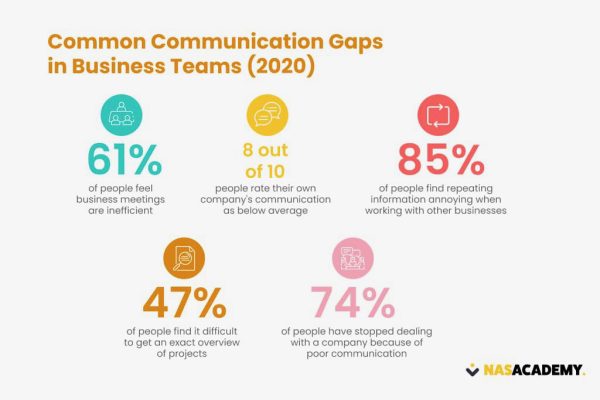https://nasacademy.com/blog/article/how-to-communicate-effectively-at-work

Communication is something so natural, that we often don’t think about it beyond its surface. But communicating with others is so much more than a skill: it’s something that is inherent to the human experience. Extrovert or introvert, we are conditioned to reach out, and connect with others.
In the world of teamwork and business, communication is crucial to help you stand out, and to help you build trust and loyalty between clients, investors, and customers.
When it comes to running your business and achieving effective teamwork, communication is key. If nobody talks to each other or has a clear understanding of positions, tasks or expectations, your entire venture will fall apart – no matter how brilliant or unique the concept.

Effective communication can be defined as a successful transfer of information. Obviously, communication is so much more than this short definition, but that’s what it comes down to.
What communication does, however, is create connections between people – and that’s what is so important about building effective communication skills in your workplace. Valuing and executing proper communication between people in your company is essential to effectively run any business – but how do you actually do this?
Well, a great place to start is by incorporating a range of communication techniques into your repertoire. Don’t worry, we’ll cover some of the best ones in this article. You may have encountered one or two of them before, while others may come as a surprise.
These types of communication come together to create a well-connected team that thrives in their work. But good communication goes far beyond just knowing what other people are doing or what’s going on in other areas of the company – it’s about fostering a positive work culture; and happy teammates means better productivity.
Effective communication also facilitates trust in your business, trust from your workers, and trust from your clients.
A 2021 study found that 86% of workers and their bosses cited poor communication as the main reason for failures in the workplace. Conversely, a report from McKinsey found that good communication in teams can increase productivity by as much as 25%.
One’s productivity is greatly affected by their feeling of belonging, trust and connection around their work – and as stated by the International Journal of Business and Management, “Trust and commitment do not just happen; they are forged and maintained through effective communication.”

Not only does poor communication result in poor teamwork, it can also result in major money losses. A Holmes report that studied 100,000 different employee companies, linked poor communication to a cumulative loss of a mind-boggling $37 billion.
The way we communicate has vastly changed over the years – especially with the rise of social media. We now have this accessible medium that’s perfect for teams to communicate and for companies to reach wider audiences.
This new world of communication has evolved so greatly and so quickly, creating a landscape riddled with both challenges, and triumphs.
Communication is something that is tricky to master, but, once your team finds its groove, it’ll be as easy as breathing. People will be happier, and your team’s productivity and work culture will improve significantly – two things that are essential to success.
Now, are you ready to start improving your team’s communication strategy? Here are some simple tips to help you get started:
You might wonder what storytelling has to do with communication and teamwork…
Spoiler: it’s a lot more than you might think! Storytelling, after all, is the art of communication. An effective story is effective communication, a stage where often the teller isn’t even present. After all, stories convey important messages and allow people to build connections and relationships with others – just like effective communication does in the workplace.
Learning this art of effective storytelling can teach teams to communicate effectively, no matter the company or environment.
Storytelling is, at its core, a two-way communication process where information is encoded and decoded. Think of all the best public speakers – they’re so engaging and are able to hold their audience’s attention. Why? Because they’re good storytellers.
Being a good storyteller also helps you avoid those dreaded situations of “miscommunication” that can be disastrous to your team. It becomes less likely because members will be more willing to listen and engage, and won’t tune out when instructions are being given.
Not only are you more likely to hold your team’s attention by implementing proper storytelling techniques into your communication strategy, but research has found that good storytellers develop and foster trust with their audiences; and trust is one of the most important things in business.

Storytelling fosters this trust because you learn how to be completely open and collaborative when explaining your team’s process from start to finish. You won’t lose your clients and audience’s engagement, and you’ll all be on the same page. When trust and open communication is encouraged and normalized in the narrative you have going between teams, people won’t be afraid to ask questions or converse with you to clarify.
Good storytelling is also a great tool when marketing to potential clients and customers. Fostering trust and engagement is essential when pitching and interacting with clients, and team members with this skill will have a distinct advantage when closing a deal. Storytelling is a transferable skill that will change the way your team works and your business operates – for the better.
Here are some ways you can implement storytelling into your leadership and team work:
This is just one of the many ways creators tell stories, and it’s called the “Three Act Structure.” As you can see, this structure seamlessly slots into the business world as well. There are other ways of storytelling for businesses that will help foster effective teamwork, but this is a great place to start on your journey to effectively communicating with your team and clients.
Storytelling has only recently been considered as a skill for leaders and team players, but it’s already being considered as an alternative to communicate information in fields, such as science.
Smart leaders use storytelling. It’s a fact. And this approach isn’t just for writers – it’s a fantastic communication skill for any leader, that takes a lifetime to develop and refine across your professional life.
Being a good storyteller also means being a good listener. We’ve all heard at one point or another that being a good listener is a desirable characteristic in any team member – but what does being a good listener truly entail?
Hearing is an automatic process, but there’s a reason so many communication trainers and employers emphasize listening over hearing: listening requires concentration, thought, and engagement.
While it’s important that the speaker is engaging enough to hold the attention of their audience, it’s still the responsibility of the listener to pay attention – even if the speaker is as dry as a bone.

The fact of the matter is, good listeners make better team members.
Good listeners:
Listening also involves knowing how to read body language and posture. This has become one of the challenges in the age of remote work due to the pandemic (reading body language is much harder over a Zoom call than when the speaker is right in front of you) and has become that much more important.
Mirroring the speaker’s posture and facial expressions while they are speaking is considered a positive sign of listening to speakers, and fosters better relationships. Listening may be a passive form of communication, but it’s essential for everyone on the team if you want them to communicate effectively. Leaders and managers also need to develop their listening skills if they want to form connections with clients and those who work for them.
Empathy has become something of a buzzword since the beginning of the COVID pandemic – and for good reason. Related to listening (as they fall on the passive end of the communication scale), empathy and emotional intelligence are positive traits to develop in all team members for effective communication.
This is even more true in the rise of the pandemic, and the fall of in-person meetings.
Communication that lacks empathy or emotional intelligence is something that stands out all the more when dealing with people remotely, and yet is something that becomes more difficult when you’ve only ever seen a portion of a person’s face on a computer screen.
It’s because of this that special attention needs to be placed on developing EQ and social skills – not only with customers and clients, but with the team. Team members who have developed their social skills and EQ are masters at communication because they focus on the success of the team, rather than on themselves as individuals.

When the whole team is uplifted, everybody wins. Learning how to communicate effectively with empathy will translate to interactions with customers as well as the production value of your product or service. In this digital age, people who can connect with others on an emotional level achieve a deeper form of communication than those who only brush the surface, and do the job they’re paid to do.
Another advantage of developing empathy in your team is that you’ll be able to understand the concerns and needs of your clients better, and work with them more effectively. Teams need to form human connections with each other if they’re going to be successful at working together towards a singular goal – and wanting to understand one another is one of the most fundamental human traits.
Investing in empathy fosters trust from the customer, and taking the time to show that you care and understand their concerns goes a long way in building that trust.
Here are some practical ways to better your team’s empathy:
As a side note, another effect in the rise of remote work is the rise in AI programming that is taking the place of workers. One area that A.I consistently fails at is connecting with customers. This competition has resulted in the rise of what’s been named the Empathy Economy, where creative thinking, empathy, and community are stressed as innate qualities of humanity that robots cannot emulate (yet).
Just one more reason to invest in this very attractive communication tool.
You can be one of the best speakers in the world, but the saying “a picture speaks a thousand words” still rings true.
Visuals are a great communication tool, and they can be anything – from a picture that helps break text to give the eyes a break, to an infographic that makes information simpler and more engaging.

Use visuals liberally in your presentations to your team. It has been proven that visuals improve engagement and information retention. Just make sure you know the right visuals to use, to communicate the meaning you intend. It’s well worth it to hire a good designer or even a design team, depending on your budget.
Although it’s a small change, visuals can change how your team engages with what you say.
We live in the age of social media, and this tool can be used to help streamline communication across your team. Video call apps, such as Zoom and Microsoft Teams, have eliminated the need for in-person communication – which comes with its own set of positives and negatives.
Instant messaging apps aimed at facilitating large groups of people, like Slack or Lark, are effective and simple communication tools to use as well. It allows you to have everyone’s contact details and other information stored in one place, and you can make team chats where members can collaborate, connect, and address everyone in the organization at once if needed.
These apps focused on teamwork and communication can be used to encourage collaboration amongst team members, and foster trust and connections across departments.

As mentioned, well-connected teams are more productive. These connections play a part in creating a good work culture – of which over half of surveyed employees state as their reason for remaining at a company. Collaborative work spaces are increasingly seen as favorable, especially amongst millennials, and you have more tools than ever to facilitate these collaborations and improve your team’s overall communication.
Technology does have its drawbacks, the most obvious being the removal of in-person communication.
People learn to communicate by being around other people, not by seeing video pictures on a screen. This can cause a disconnect when trying to build an emotional connection with your audience – and because of this disconnect, it’s become more important than ever to ensure you develop good communication skills such as genuine empathy, active listening, and most importantly: good storytelling
5 years ago, the world had 5 million social media creators. Today, that number is over 50 million.
Welcome to the Creator Revolution. Now, for the first time ever, you can actually get a job doing what you love.
You can be a social media manager, a digital marketer on TikTok, or a community manager on Discord. Not only are these the world’s newest jobs, they are guaranteed to be in-demand in future. And they are way more fun than your average 9 to 5, and pay even better! But there hasn’t been one single place to learn all these skills. Until now.
This is the Creator Accelerator Program. We designed this program to help you skyrocket your career as a creator. From learning how to grow on social media platforms, to building a network and accessing job opportunities with the world’s top brands – this immersive program will transform your career in just 5 months.
By Admin Nas Academy
By Team Nas Academy